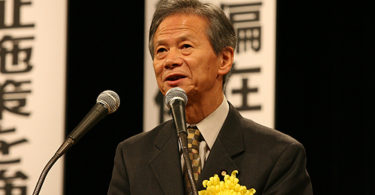One of the execution chambers where Japanese death row inmates are hanged has been revealed to the public for the first time.
The pictures are a result of the current justice minister’s decision to grant journalists access – she is a staunch opponent of the death penalty, although she has nonetheless authorised and witnessed executions as part of her official duties. She intends to review the practice.
The Tokyo execution facility made public is one of 7 nationwide.
Prisoners are executed by hanging, with a carefully calculated drop through a trapdoor designed to break the neck of the prisoner, giving something approaching an instant death.
The execution chamber is decorated much as a conference room might be, but directly below is the drop room, a much more utilitarian area. Both areas are visible from a viewing gallery. The metal rings visible in the pictures are for securing the rope.
The trapdoor is dropped by one of 3 switches, which are pressed simultaneously by 3 guards so that no one knows who directly triggered the execution.
This is a method similar to that used in some firing squad executions (only one firer will be given a rifle with a live round) so that nobody knows who fires the fatal shot, although experienced shooters can generally distinguish between live rounds and blank rounds, so this perhaps owes more to a sense of plausible deniability than anything else.
Prisoners can say their prayers before a golden Buddha.
Executions in Japan are now solely of suspects convicted of multiple murder charges, or those who murder under particularly aggravating circumstances, and public support for the practice remains high.
Japan has almost a hundred death row inmates, many of whom have been awaiting execution for years, and they are generally executed at a rate of less than half a dozen each year. Conditions for death row inmates are said to be particularly harsh.
The circumstances surrounding the executions themselves are particularly noteworthy – each execution must be personally authorised by the minister of justice, and the approval of the executions is shrouded in secrecy, with executions often timed to ensure minimal public attention.
Prisoners themselves hear that their execution has been scheduled a few hours in advance. Families, legal counsel and the media only hear about the execution after it has occurred.
The number of executions carried out based on false convictions is not known, but a number of those sentenced to death but not actually executed have been declared innocent after a retrial, and sufficient doubts have remained about others on death row to dissuade ministers and courts from actually scheduling their execution – some in fact have died of old age waiting to be executed as a result of these doubts.
Nothing is known about the rate of botched executions in Japan, but in the unusual event that a prisoner’s neck is not broken by such a fall they can usually be relied upon to be strangled to death by the noose. A drop which is miscalculated can also cause decapitation – again there are no recent public records of this.
In other countries it is common for executioners to informally finish off prisoners who survive the initial drop by some means.
Secrecy about the practice ensures no records of botched Japanese executions exist, but there is the famous case of a 31-year-old farmer sentenced to death for committing the crime of arson during a rice riot in 1872, near the beginning of the Meiji Restoration and just after Japan had begun introducing western style hanging and criminal justice.
He was hanged, but after the corpse was claimed by his relatives moaning was heard from the coffin – he had revived, despite being declared dead in an autopsy. He was taken back to his village, and soon reported to the authorities.
Reasoning that as the execution had already been carried out, and referring to practices where sovereigns would grant clemency to those who survived executions, the court’s verdict was that “as the condemned has already been hanged once, he shall not be hanged again – he is to be restored to the family register at once.”
He is said to have lived either to 1898 or to 4 years after the execution, though perhaps as a result of injuries sustained in the hanging he was a changed man and lived his life out in solitude in a hut. Nobody was punished for botching the execution, but three officials resigned out of shame at their failure.














Look as horrid as this sounds, if your gonna do excutions it needs to be more open. or its room for imperial governments to exploit it. If it was fair thered be fair court cases. if were told we need to be more open. why must there be a double standard knowing when a criminal dies for there crime doesnt harm “national security” and usually the media would take pride in announceing a crimals punishment.
That’s a little freaky…
BUT:
It is a lor better than the Ones we had in the UK!
The chance of executing an innocent person is one of the main reasons why I am for getting rid of the death penalty.
Another one is that no group of people is better than any one person when it comes down to it, and they do NOT have the right to say that someone ‘deserves to die’ unless they are going to cede that same right to that person.
Hmm they should make the lower room a kareoke room and rent it out for halloween party’s and mid way through when they least expect it activate the hatch with a sex doll on the end of the noose.
Err what happen to Nanase Ren in Night Shift Nurse since she killed the doctor due to protecting her soon-to-be-born child.Will she get death sentence too?